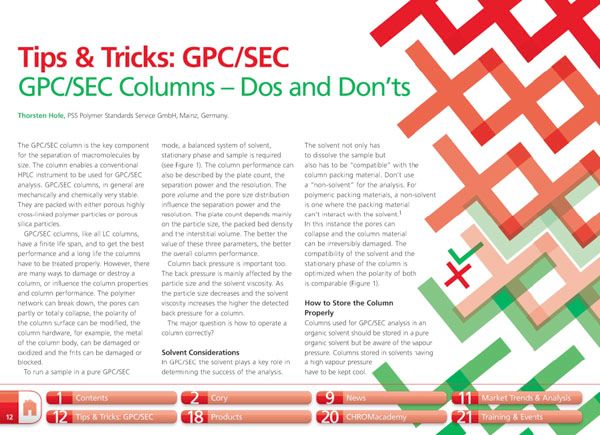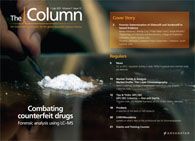Tips & Tricks: GPC/SEC Columns - Dos and Don'ts
The GPC/SEC column is the key component for the separation of macromolecules by size. It enables a conventional HPLC instrument to be used for GPC/SEC analysis.
The GPC/SEC column is the key component for the separation of macromolecules by size. The column enables a conventional HPLC instrument to be used for GPC/SEC analysis. GPC/SEC columns, in general are mechanically and chemically very stable. They are packed with either porous highly cross-linked polymer particles or porous silica particles.
GPC/SEC columns, like all LC columns, have a finite life span, and to get the best performance and a long life the columns have to be treated properly. However, there are many ways to damage or destroy a column, or influence the column properties and column performance. The polymer network can break down, the pores can partly or totally collapse, the polarity of the column surface can be modified, the column hardware, for example, the metal of the column body, can be damaged or oxidized and the frits can be damaged or blocked.
To run a sample in a pure GPC/SEC mode, a balanced system of solvent, stationary phase and sample is required. The column performance can also be described by the plate count, the separation power and the resolution. The pore volume and the pore size distribution influence the separation power and the resolution. The plate count depends mainly on the particle size, the packed bed density and the interstitial volume. The better the value of these three parameters, the better the overall column performance.
Column back pressure is important too. The back pressure is mainly affected by the particle size and the solvent viscosity. As the particle size decreases and the solvent viscosity increases the higher the detected back pressure for a column.
The major question is how to operate a column correctly?
Polysorbate Quantification and Degradation Analysis via LC and Charged Aerosol Detection
April 9th 2025Scientists from ThermoFisher Scientific published a review article in the Journal of Chromatography A that provided an overview of HPLC analysis using charged aerosol detection can help with polysorbate quantification.
Removing Double-Stranded RNA Impurities Using Chromatography
April 8th 2025Researchers from Agency for Science, Technology and Research in Singapore recently published a review article exploring how chromatography can be used to remove double-stranded RNA impurities during mRNA therapeutics production.















